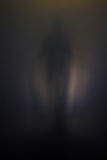TUMULT

“Riotous storm systems, lightning bolts: the staccato light is an external representation of the visions she sees while deep in meditation.” – Fast Company

TUMULT
“Tumult is a snapshot of the artist’s interior world at a singular moment in time, much like a photograph captures the external world.” – Fast Company
As Fast Company notes, “riotous storm systems, lightning bolts: the staccato light is an external representation of the visions she sees while deep in meditation.” Yet Tumult is not simply an act of revelation. It is a rite of passage into what Chavez calls a “mindful communion,” an immersive field in which the boundaries between performer and audience, self and other, begin to dissolve. Drawing on the discoveries of mid-20th century neuroscientist W. Grey Walter—who found that flickering light could alter brainwave patterns across the entire cortex—Chavez transforms the viewing experience into a process of neural entrainment. The audience’s cognitive rhythms begin to synchronize with hers, collapsing the distance between inner state and outer perception.
The stroboscopic field becomes not only a technological extension of the mind, but a space of liminality—where ordinary perception breaks down and alternate forms of awareness take shape. Operating at the threshold between vision and blindness, signal and saturation, Tumult echoes the apophatic tradition in mystical thought: a transcendence achieved not through clarity, but through overwhelm. Like the radiant obliteration of Paul’s Damascus vision or the chromatic ecstasies of Hildegard of Bingen, Chavez’s light floods perception to such an extent that it begins to unmake the known, preparing the psyche for an encounter with the formless.

Simultaneously, Tumult engages a cybernetic dimension of performance. By interfacing her own brainwaves with machine output, Chavez becomes a responsive node within a feedback system—distributing authorship across body, code, and light. This hybrid choreography transforms consciousness itself into an aesthetic medium, collapsing distinctions between subject and instrument, expression and measurement.
The work is part of Chavez’s ongoing research-based series, On the Science of Mystical Vision, a decade-long collaboration with neuroscientists at Goldsmiths College and Queen Mary, University of London. Through this body of work, Chavez contributes original insights to the neuroscience of creativity and models a radical redefinition of consciousness—not only as subject matter, but as an active material in the making of art.
In Tumult, the mind becomes environment, signal becomes sensation, and light becomes a volatile threshold between what can be known and what must be felt. What begins as storm becomes initiation—an invitation to surrender to the unseeable within.
Details
Tumult, 2014-present
Immersive performance installation
Originally presented by House of the Nobleman in London, UK on the occasion of Frieze Week
Featuring an original stroboscopic biofeedback meditation technology co-invented by Lia Chavez and rehab
Photography credit: ioulex
Credits
Artistic Director and Performer: Lia Chavez
Presenter and Curator: House of the Nobleman
Code and Hardware Developer: rehab
Neuroscience Consultants: Dr. Joydeep Bhattacharya and Dr. Caroline Di Bernardi Luft
Curatorial Consultant: Tali Wertheimer
Producer: Two Rams
Selected Press


Tumult (2014)
An Immersive Performance Installation
Presented by House of the Nobleman
In Tumult, Lia Chavez plunges the viewer into a hypnotic, high-intensity environment that the BBC has described as “wraithlike, primal, violent, frightening, and utterly, utterly hypnotic.” This immersive performance conjures a storm not of weather, but of mind—casting light as both signal and substance in a visceral exploration of consciousness and the architectures of perception.
At the heart of Tumult is Chavez’s live performance using a groundbreaking stroboscopic biofeedback meditation technology she developed in collaboration with the London-based creative studio rehab. Debuting here for the first time, the system translates Chavez’s brainwave activity into strobe light pulses in real time. Custom code reads her neural oscillations and, via Bluetooth, transmits the data to a strobe, which modulates its frequency and intensity in response to her meditative state. In deep meditation, the strobe flares with lightning-like brilliance; in lighter states, its flicker softens—offering a raw, sensory translation of her internal experience.
